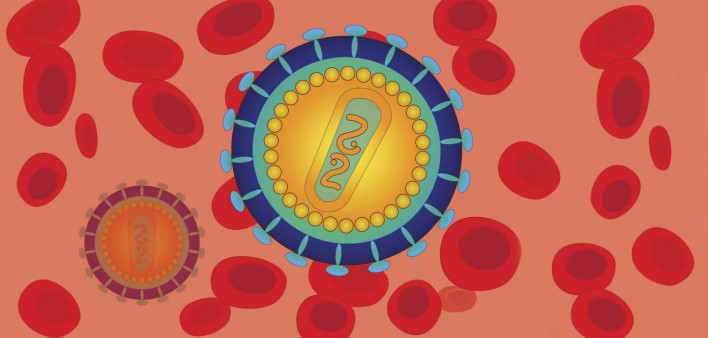People with HIV who start antiretroviral treatment very soon after infection experience a faster decline in the size of the viral reservoir in CD4 T cells, according to study findings reported in a recent preprint. [Editor’s note: this research was published in Nature Communications on November 18, 2024.]
While early treatment usually does not prevent viral rebound after stopping antiretrovirals, a smaller reservoir could raise the likelihood of long-term remission in cure studies.
“Our data add considerable insight to our current understanding of the timing and modification of early HIV reservoir establishment and stabilization,” Alton Barbehenn, PhD, of the University of California San Francisco, and colleagues wrote.
While antiretroviral therapy (ART) can keep HIV replication under control indefinitely, the virus inserts its genetic blueprints into the DNA of human cells and establishes a long-lasting latent reservoir that is unreachable by antiretrovirals and generally invisible to the immune system. This so-called HIV provirus can lie dormant in resting CD4 cells during treatment, but it starts churning out new virus soon after antiretrovirals are discontinued, making a cure very difficult.
The viral reservoir is established within days after infection and largely stabilizes by the time most people start treatment during chronic infection. Prior research has shown that people who start ART during primary infection (the first six months) have a smaller viral reservoir and may have delayed viral rebound—or, rarely, posttreatment viral control—in cure studies. However, “HIV cure trials to date have largely failed to demonstrate a clinically meaningful reduction in the size of the HIV reservoir and/or lead to sustained ART-free remission,” the study authors wrote.
The only way to tell for sure whether an intervention leads to long-term remission is to stop ART with careful monitoring, known as an analytic treatment interruption. But mathematical modeling can shed light on viral dynamics and control without the attendant risk of disease progression and HIV transmission while off antiretrovirals. Modeling data “would be immensely useful in future HIV cure trials to compare expected reservoir decay rates in comparison to curative interventions and allow generalizability of findings to a more global population of people with HIV treated during acute or chronic infection,” according to the researchers.
Barbehenn’s team developed a novel mathematical model to predict reservoir decay using a test that measures proviral DNA in peripheral CD4 cells in circulating blood. They looked at both intact, or replication-competent provirus that can produce new infectious viral particles and defective proviral DNA that can’t produce infectious virus. Study findings were presented at the 2023 International AIDS Society Conference on HIV Science and have now been reported in a preprint that has not yet been peer reviewed.
The researchers collected more than 500 blood samples over time from 67 people in the UCSF Treat Acute HIV cohort who started ART during acute infection, or up to 100 days after the estimated date of infection. Most were gay or bisexual men, reflecting the local epidemic. About 40% reported prior pre-exposure prophylaxis (PrEP) use, and 20% reported PrEP use in the past 10 days. Those who reported PrEP use had a lower baseline viral load but not a smaller viral reservoir. All participants were followed for six months. About two thirds joined the UCSF SCOPE HIV cohort and received additional follow-up.
The models showed biphasic decline of proviral DNA out to one year. During the first phase of decay, lasting up to five weeks, there was a rapid, steep decrease in intact DNA followed by a much slower decline during the second phase. The first-phase decline was comparable to previous estimates for people who started ART during chronic infection, but the second phase decay was about five times faster compared with prior estimates.
Predicted reservoir decay was faster for people who started ART sooner, those with a higher initial CD4 count and those with a lower pretreatment viral load. During the first phase of decay, the half-life of intact proviral DNA was about 14 hours longer for every week ART initiation was delayed. During the second phase (five to 24 weeks after infection), the viral half-life was about eight days longer for every week of ART delay. “Concretely, this means that a patient who initiates ART 30 days post infection has an average intact HIV reservoir decay half-life of ~2.5 months while a patient who initiates ART 100 days post-infection has an average intact HIV reservoir decay half-life of ~6.3 months,” the study authors wrote.
Similar patterns of decay were seen for defective proviral DNA in this cohort of people treated during acute infection. Prior studies of people treated during chronic infection have shown that intact provirus decays more quickly than defective proviral DNA during long-term ART, perhaps because replication-competent provirus is more readily detected and cleared by the immune system.
“[T]hese data add to our limited understanding of host viral control at the earliest stages of HIV reservoir stabilization, potentially informing future HIV cure efforts aimed at diverse, global population of people with HIV initiating ART at varying stages of disease,” the researchers concluded.
The initial rapid decline in proviral DNA in the first phase is thought to reflect the death of infected CD4 cells after ART initiation during either acute or chronic infection. But people who start treatment early have less exhausted immune cells and more intact immune responses, the authors noted. These findings could help personalize HIV cure strategies, suggesting that people who start antiretrovirals very soon after infection may achieve remission more easily, while those who start during chronic infection may need additional interventions.
“Potential promising therapeutic interventions may be optimally studied in specific patient populations, but results from such studies can still inform future therapies for all people with HIV,” they wrote. “For example, chronic treated people with HIV may benefit from the same curative interventions as acute treated people with HIV but might require adjunctive therapies to reverse cell exhaustion.”
Click here for more news about HIV cure research.







Comments
Comments